|
Need Help?
|
|
Call
1-800-372-3706
to
speak to a Veterinary Behavior Technician |
|
Paws To Speak!
Members
Main Menu
|
|
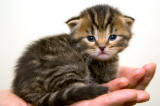 |
 |
|
Help is at your
fingertips by library, email, and phone. |
Library
Topic
Behavioral Aspects of Postnatal Care
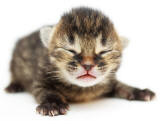
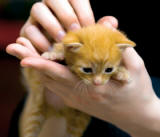
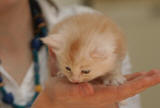
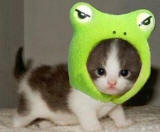

|
Early Kitten Development
Newborn
to 7 days
Kittens are born blind and deaf
until about 7 to 10 days of age.
The newborn's ears are flat
against the head and the eyes
are closed. A newborn kitten can
ambulate - squirm around - and
uses its sense of smell to find
a nipple on the mother cat.
About day 3, the umbilical cord
falls off. A newborn
kitten cannot regulate body
temperature for two weeks so
needs to be near littermates or
mother. Orphans must be kept in
a warm room with a heating pad -
covered with a fluffy towel - on
low available so the kitten can
move on and off of it at will.
The mother cat must stimulate
elimination by licking the
genital area.
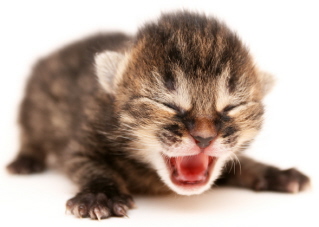 First two weeks First two weeks
The kitten opens
its eyes and begins to hear in
one to two weeks and can hold
its head and chest up and walk,
although wobbly. Purring begins
in the second week usually while
the kitten is nursing. The
mother cat also purrs while
nursing her kittens - some
believe this is a signal or sign
of relaxation and contentment.
Others feel it is simply a
social signal and usually
demonstrates affection.
|
From approximately two to
five months of age kitten
teeth emerge as sharp,
narrow teeth for play
hunting
consuming solid food . |
.jpg)
Two to four weeks
Teething is when
new teeth break through the
gums. The kittens tiny front
teeth begin to emerge at 2 to 3
weeks of age. The kitten walks
with better balance and begins
to play by three weeks of age.
Ears begin to swivel by three
weeks and fangs may begin to
emerge. At 3 to 4 weeks of
age, the kitten begins to
eliminate on its own. The lower
molars begin emerging by 4 to 5
weeks. Kittens that are gently
handled for a few minutes each
day beginning around this time
are more likely to accept humans
as friendly and accept handling
as adult cats.
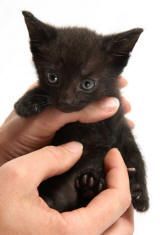 Five to eight
weeks Five to eight
weeks
It becomes
increasingly uncomfortable for
the mother to nurse. She
eventually pushes the kittens
away from nursing and begins to
bring them solid food. The
weaning process begins. At six
weeks of age, the kitten's eye
color changes from baby blue to
the adult cat color. Object play
begins and increases during this
time to include running,
climbing and scratching
behaviors. This is a perfect
time to introduce litterboxes,
cat scratching and climbing
posts, and interactive play with
cat toys. This is also the very
best time to socialize your
kitten to every and any person,
place, event or thing that you
want your adult cat to accept
without fear or a fight. The key
is to introduce all things in a
controlled, positive manner
using praise, treats, and toys,
and most importantly, moving
toward your goal in baby steps.
Early rules of thumb
Never
yell or hit your kitten for any
reason. Supervise all indoor
exploration for safety and to
gently remove the kitten from
unwanted areas or to interrupt
unwanted behaviors. Keeping your
kitten in a small room with a
variety of litterboxes - that
are easy to get into - and a
safe climbing and scratching
posts will help your kitten
develop good habits that last a
lifetime.
|
Preventing bad habits is easier than correcting established behavior
patterns. |
|
 |
|